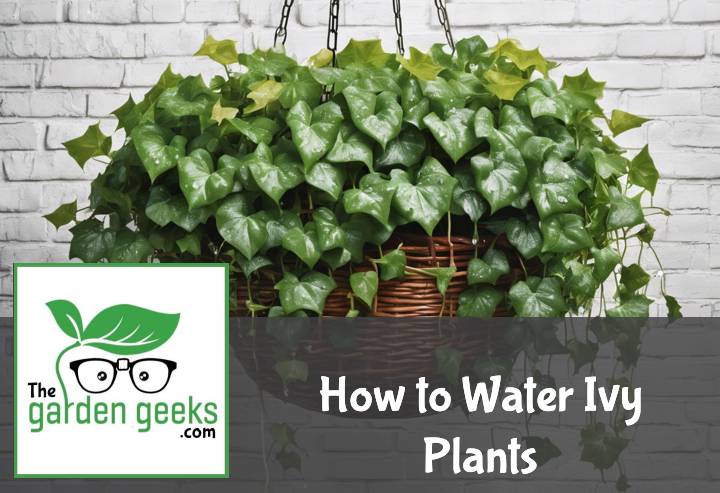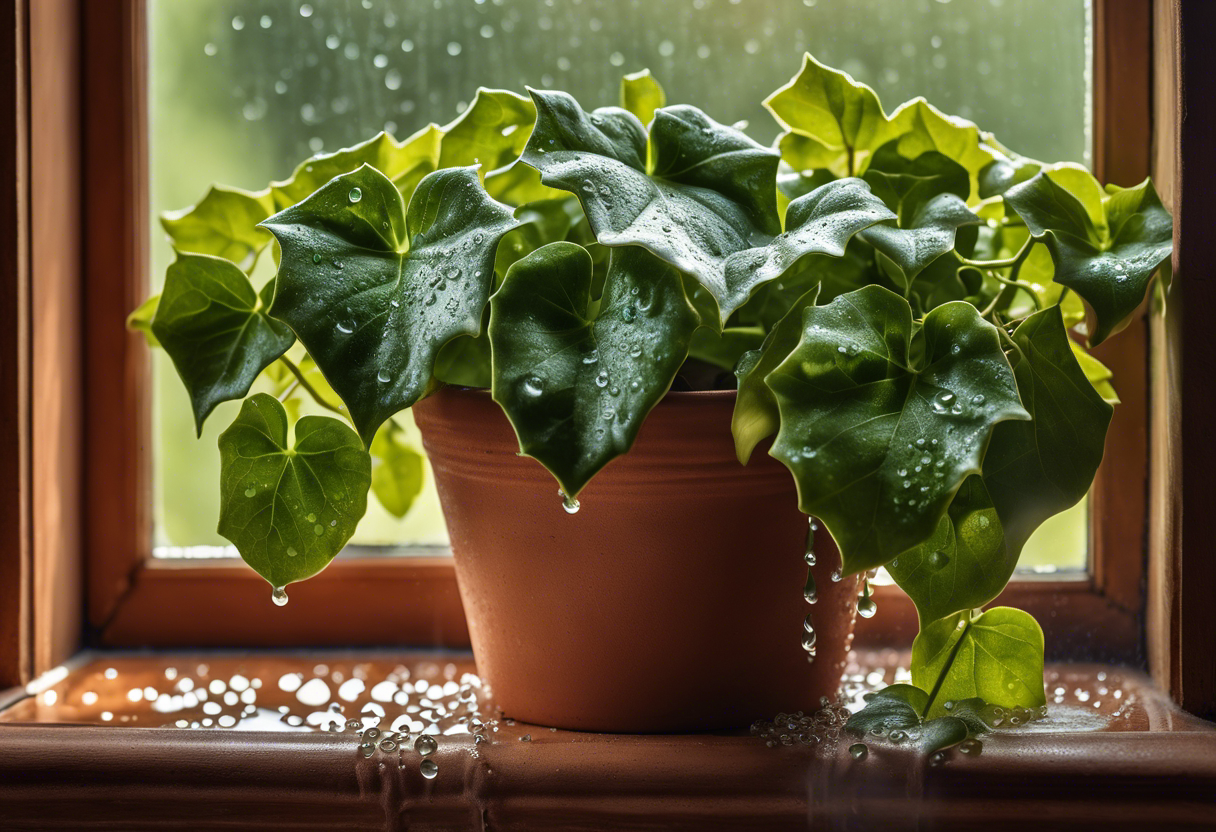Hello, green thumbs! Ever found yourself wondering How to Water Ivy Plants? Trust me, you’re not alone. These leafy beauties can be a bit finicky when it comes to their H2O needs.
But don’t worry! I’ve got some tips and tricks up my sleeve that’ll turn you into an ivy-watering pro in no time. So grab your watering cans, folks. It’s time to dive into the world of ivy hydration! Keep reading about How to Water Ivy Plants.
Key Takeaways
- Ivy plants prefer indirect sunlight and cool temperatures.
- Water ivy when the top inch of soil is dry, usually once a week.
- Overwatering can lead to root rot, so ensure proper drainage.
- Use room temperature water to avoid shocking the plant.
- Mist leaves regularly to maintain humidity and prevent spider mites.
- Fertilize monthly during growing season with a balanced houseplant fertilizer.
Understanding Ivy Plants
Let’s talk about ivy plants, shall we? These green beauties are known for their resilience and versatility. They can grow just about anywhere, but they do have some specific needs. One of those is water. Yep, you heard it right! Just like us humans, ivy plants need water to thrive. But here’s the kicker – not all ivy types require the same amount of H2O. So, if you’re thinking about how to water ivy plants, you gotta consider the type of ivy you’ve got.
The Importance of Water for Ivy Plants
Water is like a magic potion for ivy plants. It helps them grow, keeps them healthy, and gives them that lush green look we all love. But too much or too little can spell trouble in paradise!
Underwatering your plant might leave it parched and droopy – a definite no-no in the world of ivy plant care. On the other hand, overwatering can lead to root rot and other nasty stuff. So remember folks, when it comes to watering ivy plants, balance is key!
Types of Ivy and Their Watering Needs
Now let’s dive into different types of ivy and their watering needs. English Ivy? She’s a thirsty gal who likes her soil moist but well-drained. Boston Ivy? He prefers slightly dry soil between waterings.
And then there’s Algerian Ivy – she likes her drinks in moderation! Too much water makes her uncomfortable (root rot isn’t fun!). So if you’re caring for this type of ivy, make sure not to overdo it with the watering.
In conclusion folks, knowing your type of ivy will help you understand how to best care for it when it comes to watering. Remember: every plant has its own personality and needs!
How Often to Water Ivy Plants
When it comes to how to water ivy plants, the frequency is key. Whether you’re dealing with indoor or outdoor ivy, getting the watering schedule right is crucial for healthy growth.
Indoor Ivy Watering Frequency
Indoor ivy plants are a bit like Goldilocks – not too much, not too little, but just the right amount of water. Typically, you should aim to water your indoor ivy once a week. But remember, this isn’t a hard and fast rule.
Factors such as temperature, humidity levels and the size of your plant can influence this indoor ivy watering schedule. If you’ve got your heating cranked up during winter or live in a particularly dry area, your plant might need a drink more often.
On the other hand, if you’re lucky enough to live in a humid climate (or just love using your humidifier), then your houseplant watering frequency might be less. The key here is observation – keep an eye on your plant’s leaves and soil moisture levels to determine when it’s thirsty.
Outdoor Ivy Watering Frequency
Outdoor ivy plants are a different kettle of fish altogether. They’re exposed to elements like wind and rain which can affect their hydration needs.
Generally speaking, outdoor ivy should be watered once or twice a week depending on weather conditions. If Mother Nature has been generous with rainfall, then you might not need to water at all.
However, if it’s been hot and dry (think summer BBQ weather), then your outdoor ivy watering schedule may need ramping up. Just like their indoor counterparts though, keep an eye out for signs of dehydration in your outdoor ivy plants.
Best Time to Water Ivy Plants
When it comes to how to water ivy plants, timing is everything. The optimal time to water ivy can vary based on factors like temperature and sunlight. Let’s dive into the differences between morning and evening watering, and how seasonal adjustments can affect your watering schedule.
Morning vs Evening: What’s Best?
Now, you might be wondering if there’s a winner in the battle of morning vs evening watering. Well, let me tell you, it’s not as simple as picking a side!
Watering in the morning has its perks. It gives your ivy plant a good start for the day, allowing it to absorb moisture before the sun gets too hot. Plus, any excess water will evaporate throughout the day, reducing chances of root rot.
On the flip side, evening watering isn’t all bad either. It allows your plant to soak up water overnight when evaporation rates are low. But beware! If temperatures drop too much at night, your plant could end up sitting in soggy soil – not exactly an ivy’s idea of fun!
So what’s best? It really depends on your local climate and weather conditions. Just remember that regardless of when you choose to water, maintaining optimal ivy plant health should always be your top priority.
Seasonal Adjustments in Watering Schedule
Just like us humans swapping our winter coats for summer tees, ivy plants also need some wardrobe changes – or rather – watering changes with seasons!
In warmer months like summer, ivies may need more frequent watering due to increased evaporation rates. So don’t be shy about giving them a little extra H2O love during this time.
Come winter though; it’s a different story. As growth slows down during colder months, so does their thirst! Overwatering can lead to soggy roots and ultimately harm your plant. So, it’s best to cut back on watering and give your ivy a bit of a winter break.
Remember, adjusting the watering schedule for seasons is an essential part of ivy plant care. Keep an eye on the weather, and your ivy will thank you for it!
Techniques for Watering Ivy Plants
When it comes to how to water ivy plants, there’s more than one way to quench their thirst. We’ve got two main techniques – bottom-watering and top-watering. Each has its own quirks, perks, and little drawbacks.
Bottom-Watering Technique
So, what’s the deal with this bottom-watering method? Well, it’s all about giving your ivy a drink from the bottom up. You place the pot in a tray of water and let the plant do its thing. It’ll suck up what it needs through the drainage holes in the pot.
This technique is great for those forgetful gardeners out there. Why? Because you can leave your plant to hydrate itself while you go about your day. Plus, it helps keep that beautiful foliage dry and free from pesky fungal issues.
But when should you use this technique? Well, if your indoor ivy plant care routine includes avoiding overwatering or if you’re dealing with a dehydrated plant, then bottom-watering is your friend.
Top-Watering Technique
Now onto our second contender – the top-watering method. This one’s pretty straightforward. You pour water onto the soil at the top of the pot until it starts draining out of the bottom.
Ideal conditions for this method? When your ivy needs a quick drink or when you want to flush out excess salts from fertilizers in the soil.
Some folks might prefer top-watering because it mimics natural rainfall and can help prevent salt build-up in potting soil. But remember, every ivy is unique! So whether you choose top or bottom watering depends on your plant’s specific needs and your personal preference.
Signs Your Ivy Plant is Overwatered or Underwatered
When it comes to Ivy plant care, striking the right balance with watering is key. Too much or too little water can lead to a host of problems, manifesting in various symptoms. Recognizing these signs early on can help maintain your ivy plant’s health.
Symptoms of Overwatering
Overwatering an ivy plant can cause more harm than you might think. One of the first signs of overwatered ivy symptoms is wilting leaves. Despite being well-watered, the leaves droop as if thirsty.
In more severe cases, you’ll notice a waterlogged ivy plant with yellowing leaves and soft, mushy stems. This is due to excess water damage that prevents oxygen from reaching the roots.
The worst-case scenario? Root rot – a silent killer that turns healthy white roots into brown sludge. If left unchecked, it could spell curtains for your beloved ivy.
Symptoms of Underwatering
On the flip side, underwatering isn’t any better for your green friend. An underwatered ivy shows its distress through leaf drop and wilting, similar to overwatering but with a key difference: the soil will be dry to touch.
Extended periods of underwatering lead to dehydration damage in plants. The once vibrant green leaves turn brown and crispy at the edges – a cry for help from your thirsty plant.
Remember folks, understanding how to water ivy plants properly is crucial! It’s all about finding that sweet spot between not turning your plant into a swamp dweller and not leaving it high and dry either!
Tips to Prevent Overwatering and Underwatering
In the world of Ivy plant care, it’s all about balance. Too much water, and you’re drowning your green buddy. Too little, and it’s parched. So, how do we strike that perfect balance? Well, there are a few tricks up our sleeves to prevent overwatering and avoid underwatering.
Using a Moisture Meter
Meet your new best friend – the moisture meter! This handy tool helps you measure the moisture levels in the soil accurately. It’s like having a personal weather forecast for your plant’s roots! With this, you can ensure optimal ivy hydration.
But wait, there’s more! The moisture meter is also a lifesaver when it comes to preventing overwatering. Just stick it in the soil and voila! You’ll know if your plant is sipping on too much H2O.
Understanding Your Plant’s Dryness Level
Now let’s talk about understanding your ivy plant’s dryness level. No fancy gadgets needed here – just good old observation skills. Look out for droopy leaves or browning edges – these are signs of an underwatered ivy plant.
Knowing how to assess plant dryness level can be a game-changer in your watering routine. It helps you understand when your ivy is thirsty and when it has had enough drink for the day.
Remember folks, in learning how to water Ivy plants, observation is key! Keep those peepers peeled and happy watering!
To Wrap Up
Just like a kid in a candy store, your ivy plants can’t get enough of the good stuff – water! But remember, too much of anything can be bad. So now that you’ve mastered How to Water Ivy Plants, let’s keep those green babies happy and hydrated.
Remember, it’s all about balance. Too dry or too wet, and your ivy might just throw a tantrum. Happy watering!





